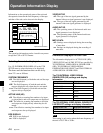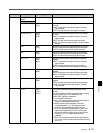
Appendix A-13
Appendix
Glossary
AES/EBU format
A standard format for the transfer of
digital audio signals. In this format, two
audio signals can be input/output through
one XLR-type connector.
Assemble editing
An edit mode for adding new scenes to the
end of previously recorded scenes. New
video signals are recorded for each control
signal, but continuity with the control
signal preceding the edit point is
maintained electrically. Because assemble
editing in the middle of a scene will cause
a break in the video image at the end of the
insertion, this is not a practical method for
inserting new video data. This should be
done with insert editing.
See also Insert editing.
Backspace editing
Also called phase matching. During
backspace editing, the VTR automatically
rewinds the tape a few seconds after
recording of a scene has been completed.
This allows the tape to attain a stable
speed before the start of recording of the
next scene, thus maintaining signal
continuity during editing.
Bridging connection
A connection that allows a signal input to
an input terminal to pass throuth the unit
and exit from an output terminal for input
to a third piece of equipment.
Capstan
A drive mechanism that moves the tape at
a specified speed. Its rotation is normally
synchronized with a reference sync signal.
Color frame
A color subcarrier phase having one cycle
that consists of two frames (four fields) in
the NTSC format.
Color frame locking
A procedure in which the time code frame
value is set to an odd number for the first
and second color fields, and to an even
number for the third and fourth color
fields.
Color framing
A method to maintain color subcarrier
phase continuity by performing editing in
two-frame units in order to achieve stable
video without horizontal fluctuation at the
edit points when editing downconverted
composite video signal.
Component video signal
A video signal that consists of a luminance
signal (Y) and two chrominance (color-
difference) signals (R-Y, B-Y).
Composite video signal
A signal that consists of video (luminance
and color sub carrier), sync (horizontal and
vertical), and color burst signals.
Condensation
Moisture that collects on the head drum of
the tape transport mechanism, causing
damage to the tape and malfunction of the
VTR.
CTL
Abbreviation for control signal. A pulse
signal that can be counted, to determine
the number of frames, and therefore the
tape’s running time. Used mainly for
adjusting the tracking position of video
heads, and to achieve time code continuity
during continuous recording. This signal is
recorded on a longitudinal tape track.
Cue point
A point used to mark the beginning of a
section of tape so that it can be located for
later playback or editing.
Drop frame mode
When the field frequency of this unit is
59.94 Hz, the actual number of frames per
second is approximately 29.97, while the
time code value advances one second
every 30 frames. In drop frame mode, the
time code is advanced such a way that this
difference in the value between real time
and the time codes is corrected.
Specifically, two frames are skipped at the
beginning of each minute, except for every
tenth minute, so that the frame value for
time codes matches that for real time.
See also Non-drop frame mode.
E-E mode
Abbreviation for Electric-to-Electric
mode. In this mode, the signals are passed
through the VTRís electronics before
output but do not pass through the
magnetic converter circuits such as the
tape and head circuits. This mode is used
for confirming input signals or adjusting
the input level.
Effect edit mode
When editing a tape using a switcher or
when editing special effects, the pixels
comprising the picture are often not
dubbed to the same positions as those of
the original. In the case of repeated
dubbings, this shifting of pixels produces
an accumulation of calculation errors
during the compression/expansion process;
this may result in an increase in low-level
noise within the signal. The effect edit
mode minimizes the production of this
noise. Note, however, that a slight loss in
picture resolution may be observed in this
mode.
Emphasis
Emphasizing the high frequencies of a
signal before processing (pre-emphasis)
and de-emphasizing those high frequencies
before output (de-emphasis). This reduces
deterioration of the signal-to-noise ratio in
the high frequency range.
External synchronization
A method to maintain color subcarrier
phase continuity by performing editing in
two-frame units in order to achieve stable
video without horizontal fluctuation at the
edit points. For editing, a recorder VTR (or
master VTR) and a player VTR (or source
VTR or slave VTR) are used, and external
synchronization is commonly used to
ensure that the operation timing control
signals and time reference signals are
synchronized.
Insert editing
An edit mode for inserting new scenes into
the middle of previously recorded scenes.
CTL signals previously recorded on the
tape are used. Consequently, this mode
cannot be used for blank tapes. This mode
assumes that CTL signals have somehow
be recorded to the tape already.
See also Assemble editing
Longitudinal time code
See LTC.
LTC
Abbreviation for Longitudinal Time Code.
This is the time code recorded onto a
longitudinal track of the tape. During the
playback of still pictures, LTC cannnot be
read since the tape is not moving. During
slow playback, the LTC output is so small
that it may not be read correctly,
depending on the playback speed.
See also VITC.


















